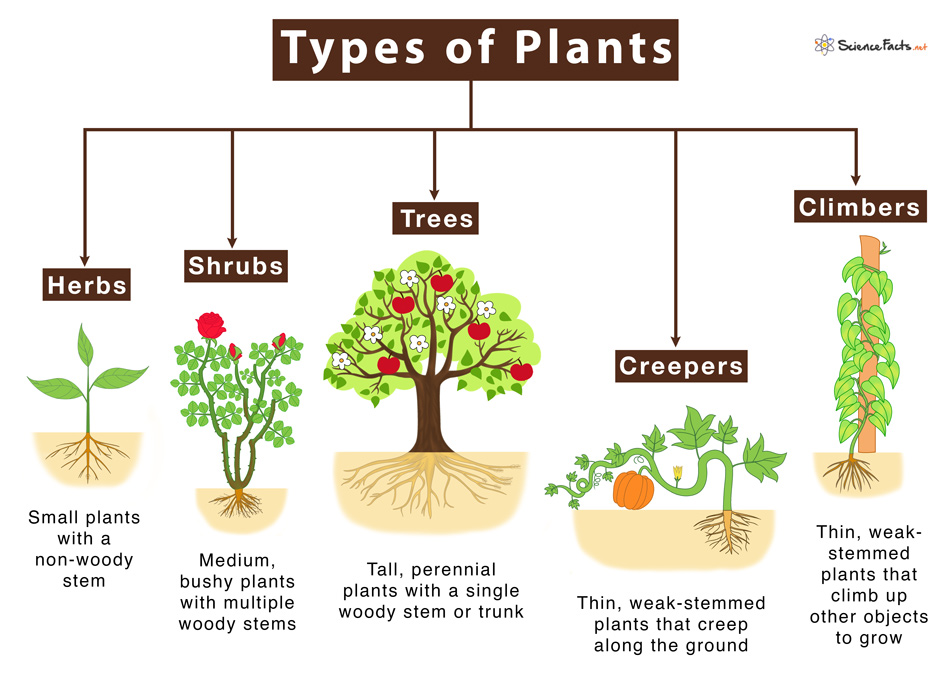Different Types of Plants
1) Herbs
They are short-sized plants with soft, delicate stems that are green in color. Herbs are typically two to three feet tall. These plants usually have only a few branches or are sometimes devoid of branches. The stem of some herbs develops hard, woody tissue as they grow old. Most herbs are perennials, living for more than two years, while some are annuals that complete their life cycle within a year. Herbs contain nutritional benefits, including vitamins and minerals that form a part of our daily balanced diet. Examples: Rice (Paddy), wheat, tomato, cabbage, mustard, sunflower, radish, and carrot.
2) Shrubs
They are medium-sized plants with a bushy, hard, and woody stem with multiple branches. Shrubs are typically fewer than ten feet in their height, thus are taller than herbs. Although their stems are firm, they are flexible enough to resist any bending stress. They usually live for more than two years and thus are perennials. Shrubs have ornamental values with decorative purposes commonly found in gardens and used in landscape design projects, houseplants, and specimen displays. Examples: Rose, jasmine (chameli), tulsi, china rose, bougainvillea, henna, pomegranate, and croton.
3) Trees
They are tall and big land plants with variable heights. Trees have an elongated, thick, hard, and woody stem called the trunk. Most trees have a trunk with multiple branches containing other essential parts such as leaves, flowers, and fruits. Some trees like coconut and beetle nut are exceptions. They are branchless and bear leaves, flowers, and fruits all by themselves. Trees are perennials that live for several years. Examples: Banyan (peepal), mango, neem, coconut, teak, oak, sandalwood, and cashew nut.
4) Creepers
They have a long, weak, and thin stem that creeps along the ground. Creepers cannot stand their weight and need another plant or any external support for their growth. Examples: Sweet potatoes, watermelon, money plant, and pumpkin.
5) Climbers
They have a thin, long, and weak stem that uses unique structures called tendrils to climb. Thus, unlike creepers, climbers are more structurally advanced and need no external support for their growth. Examples: Pea plant, sweet gourd (petha), bitter gourd, grapevine, beanstalk, passionflower, and glory lily.
Other Types of Plants
Sometimes plants are classified based on whether they produce seeds or not. Accordingly, they are grouped into two types:
Plants without Seeds
They do not produce seeds for their reproduction and are of four types: Algae: It consists of a large, diverse group of plants found to grow in water. Like many plants, algae perform photosynthesis to prepare food. Being diverse, each group is not closely related to the other. There are approximately 72,500 species of algae in the world. All algae are divided into green algae, red algae, and brown algae. Mosses: They are small flowerless plants that are located almost everywhere on earth. Mosses can grow even in the absence of soil and are often found growing on rocks, trees, soils, and concrete. There are almost 12,000 species of moss on earth. Ferns: A group of flowerless plant that grows in damp, shady areas. Unlike mosses and algae, ferns are a type of vascular plant that reproduces through spores’ formation and distribution. There are an estimated 10,560 species of ferns, among which some are oldest through evolution. Liverworts: They are small, leafy, non-vascular, flowerless plants that can be as tiny as 2mm or grow to 20mm wide. Similar to mosses, they proliferate in damp places. One of the distinguishing features of liverworts is that they are generally smaller and have tiny hair-like structures called rhizoids that absorb water.
Plants with Seeds
They are plants that produce seeds for their reproduction and are of the following types: Gymnosperms: They are a group of non-flowering, vascular plants that produce seeds not enclosed within an ovary or fruit. In simple words, gymnosperms are plants that produce seeds without fruits. Gymnosperm seeds are thus naked, open to the air. These plants develop from the surface of leaves or at the end of stalks forming a cone-like structure. Gymnosperms are perennial plants with a woody stem. Cycas, thuja, redwood, pinus, Cedrus, spruce, and Juniperus are typical gymnosperms. Angiosperms: They are a group of flowering, vascular plants with seeds that grow inside an ovary or fruit. In other words, angiosperms are plants that bear fruits containing seeds. Angiosperms produce flowers at some stage of their lifecycle that helps in their reproduction. They are the most advanced and beneficial group in the plant kingdom. Most plants that we use as food, such as apple plant, mango plant, brinjal, jackfruit, papaya, pea plant, watermelon, and litchi, are examples of angiosperms.
